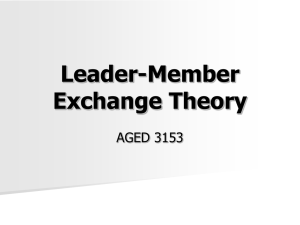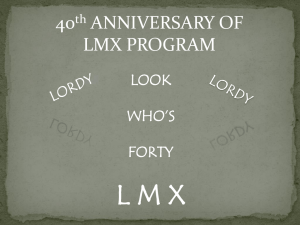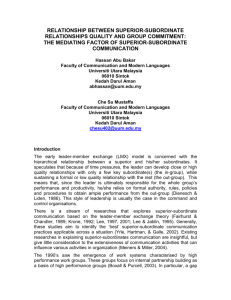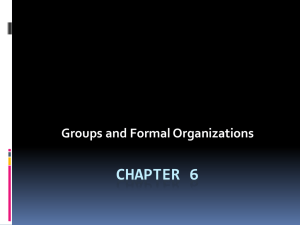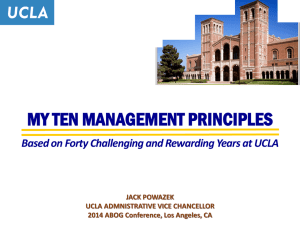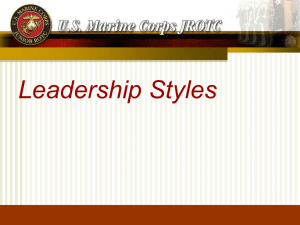Leader-Member Exchange Theory
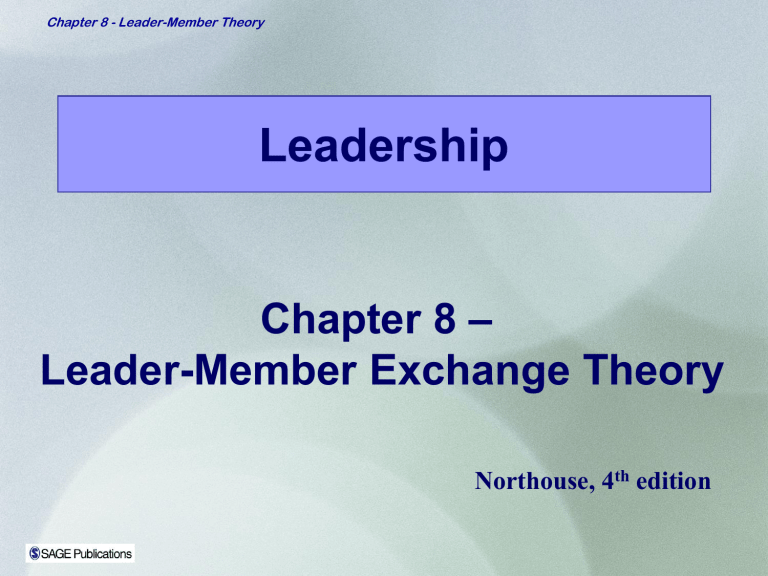
Chapter 8 - Leader-Member Theory
Leadership
Chapter 8 –
Leader-Member Exchange Theory
Northouse, 4 th edition
Chapter 8 - Leader-Member Theory
Overview
LMX Theory Description
LMX Theory Perspective
Early Studies
Later Studies
Phases in Leadership Making
How Does the LMX Approach Work?
Chapter 8 - Leader-Member Theory
Definition
Leader-member exchange (LMX) theory:
– conceptualizes leadership as a process
that is centered on the interactions between a leader and subordinates
Some theories focus on leaders :
– trait approach, skills approach and style approach
Other theories focus on the follower and the context :
– situational leadership, contingency theory, and pathgoal theory .
Chapter 8 - Leader-Member Theory
Dimensions of Leadership
LMX theory makes the dyadic relationship between leaders and followers the focal point of the leadership process
Chapter 8 - Leader-Member Theory
LMX Theory Description
Perspective
Development LMX theory first described by
Dansereau, Graen, & Haga (1975), Graen &
Cashman (1975), and Graen (1976)
Revisions Theory has undergone a number of revisions since its inception and continues to be of interest to researchers
Assumption LMX theory challenges the assumption that leaders treat followers in a collective way, as a group.
– LMX - Directed attention to the differences that might exist between the leader and each of his/her followers
Chapter 8 - Leader-Member Theory
Early Studies
First studies of
LMX called –
Vertical Dyad
Linkage (VDL)
– Focus on the vertical linkages leaders formed with each of their followers
– Leader’s relationship to a work unit viewed as a series of vertical dyads
The
Vertical
Dyad
Vertical
Dyads
Chapter 8 - Leader-Member Theory
Early Studies
Leader’s work unit as a whole was viewed as a series of vertical dyads; leader forms unique relationship with each subordinate
Chapter 8 - Leader-Member Theory
Early Studies, cont’d.
Researchers found two general types of linkages (or relationships) – those based on:
– Expanded/negotiated role responsibilities (extraroles) = in-group
Relationships marked by mutual trust, respect, liking, and reciprocal influence
Receive more information, influence, confidence, and concern than out-group members
– Formal employment contract (defined-roles) = out-group
Relationships marked by formal communication based on job descriptions
Chapter 8 - Leader-Member Theory
Early Studies, cont’d.
In-group/out-group status based on how well subordinate works with the leader and how well the leader works with the subordinate
How subordinates involve themselves in expanding their role responsibilities with the leader determines whether they become in-group or out-group participants
Becoming part of the in-group involves subordinate negotiations in performing activities beyond the formal job description
Chapter 8 - Leader-Member Theory
In-Group & Out-Group Subordinates
S
Out-Group
S
S
S
Leader
S
S
S Subordinate
S
S
In-Group
S
S
S
S
In-Group
– more information, influence, confidence
& concern from
Leader
– more dependable, highly involved & communicative than out-group
Out-Group
– less compatible with
Leader
– usually just come to work, do their job & go home
Chapter 8 - Leader-Member Theory
Later Studies
(Graen & Uhl-Bien, 1995)
Initial research primarily addressed differences between in-groups and outgroups; later research addressed how LMX theory was related to organizational effectiveness
Later research focus on the quality of leadermember exchanges resulting in positive outcomes for:
– Leaders
– Followers
– Groups
– Organizations in general
Chapter 8 - Leader-Member Theory
Later Studies
(Graen & Uhl-Bien, 1995)
Researchers found that high-quality leadermember exchanges resulted in:
– Less employee turnover
– More positive performance evaluations
– Higher frequency of promotions
– Greater organizational commitment
– More desirable work assignments
– Better job attitudes
– More attention and support from the leader
– Greater participation
– Faster career progress
“Leadership Making”
Chapter 8 - Leader-Member Theory
Leadership Making
(Graen & Uhl-Bien, 1995)
A prescriptive approach to leadership that emphasizes that a leader should develop high-quality exchanges with all of her or his subordinates, rather than just a few.
– Three phases of leadership making which develops over time:
(a) stranger phase
(b) acquaintance phase
(c) mature partnership phase
Chapter 8 - Leader-Member Theory
Phases in Leadership Making
Graen & Uhl-Bien (1995)
Scripted
One Way
Low Quality
Self
Chapter 8 - Leader-Member Theory
Leadership Making
Graen & Uhl-Bien (1995)
Phase 1
Stranger
• Interactions within the leader-subordinate dyad are generally rule bound
• Rely on contractual relationships
• Relate to each other within prescribed organizational roles
• Experience lower quality exchanges
• Motives of subordinate directed toward self-interest rather than good of the group
Chapter 8 - Leader-Member Theory
Leadership Making
Graen & Uhl-Bien (1995)
Phase 2
Acquaintance
• Begins with an “offer” by leader/subordinate for improved career-oriented social exchanges
• Testing period for both, assessing whether
- the subordinate is interested in taking on new roles
- leader is willing to provide new challenges
• Shift in dyad from formalized interactions to new ways of relating
• Quality of exchanges improve along with greater trust & respect
• Less focus on self-interest, more on goals of the group
Chapter 8 - Leader-Member Theory
Leadership Making
Graen & Uhl-Bien (1995)
Phase 3
Mature Partnership
• Marked by high-quality leader-member exchanges
• Experience high degree of mutual trust, respect, and obligation toward each other
• Tested relationship and found it dependable
• High degree of reciprocity between leaders and subordinates
• May depend on each other for favors and special assistance
• Highly developed patterns of relating that produce positive outcomes for both themselves & the organization
Partnerships are transformational – moving beyond selfinterest to accomplish greater good of the team & organization
Chapter 8 - Leader-Member Theory
How Does the LMX Theory
Approach Work?
Focus of LMX Theory
Strengths
Criticisms
Application
Chapter 8 - Leader-Member Theory
How does LMX theory work?
LMX theory works in two ways: it describes leadership and it prescribes leadership
– In both - the central concept is the dyadic relationship
Descriptively:
It suggests that it is important to recognize the existence of in-groups & out-groups within an organization
Significant differences in how goals are accomplished using in-groups vs. out-groups
Relevant differences in in-group vs. out-group behaviors
Chapter 8 - Leader-Member Theory
How does LMX theory work?
Prescriptively:
Best understood within the Leadership Making Model
(Graen & Uhl-Bien)
– Leader forms special relationships with all subordinates
– Leader should offer each subordinate an opportunity for new roles/responsibilities
– Leader should nurture high-quality exchanges with all subordinates
– Rather than concentrating on differences, leader focuses on ways to build trust & respect with all subordinates – resulting in entire work group becoming an in-group
Chapter 8 - Leader-Member Theory
Strengths
LMX theory validates our experience of how people within organizations relate to each other and the leader
LMX theory is the only leadership approach that makes the dyadic relationship the centerpiece of the leadership process
LMX theory directs our attention to the importance of communication in leadership
Solid research foundation on how the practice of LMX theory is related to positive organizational outcomes
Chapter 8 - Leader-Member Theory
Criticisms
Inadvertently supports the development of privileged groups in the workplace; appears unfair and discriminatory
The basic theoretical ideas of LMX are not fully developed
• How are high-quality leader-member exchanges created?
• What are the means to achieve building trust, respect, and obligation? What are the guidelines?
Because of various scales and levels of analysis, measurement of leader-member exchanges is being questioned
Chapter 8 - Leader-Member Theory
Application
Applicable to all levels of management and different types of organizations
Directs managers to assess their leadership from a relationship perspective
Sensitizes managers to how in-groups and out-groups develop within their work unit
Can be used to explain how individuals create leadership networks throughout an organization
Can be applied in different types of organizations – volunteer, business, education and government settings
